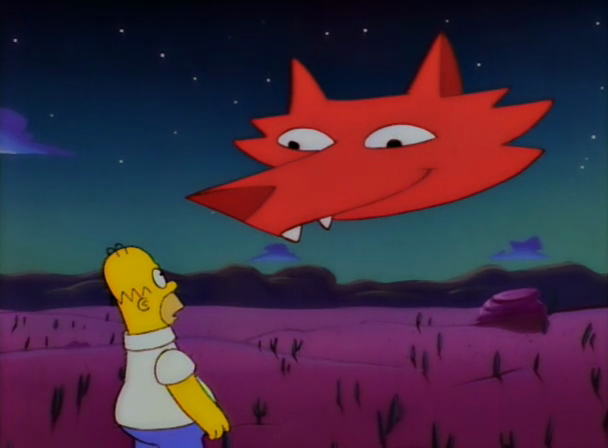3.2 Space Coyote
Thomas King’s Blue Grass, Running Water is a tale that spans multiple stories, characters, and dimensions to shape a narrative that not only critiques colonialism throughout history, but also explores the meaning of creation.
Now clearly, there are many elements in which we can explore here, but I want to focus this post on the first character we meet; or rather, the first presence of a long line of symbols and allusions we will meet along the journey.
 The Coyote plays quite the prominent role throughout the narrative as both a trickster and a healer. While it seems like our collective discussion as a whole veered towards identifying the symbol of the Coyote with the popular cartoon character Wile E Coyote, I actually immediately thought of the Coyote from an old Simpson’s episode. Of course, the “Space Coyote” (voiced by Johnny Cash) was created as a satire of various Spirit Animal tropes in popular culture, but its place within the story of the episode is quite relatable; it was a bridge between fantasy and reality, and even though it was a manifestation of the mind, it still drove the narrative forward through the re-telling of a story lost deep within Homer’s subconscious.
The Coyote plays quite the prominent role throughout the narrative as both a trickster and a healer. While it seems like our collective discussion as a whole veered towards identifying the symbol of the Coyote with the popular cartoon character Wile E Coyote, I actually immediately thought of the Coyote from an old Simpson’s episode. Of course, the “Space Coyote” (voiced by Johnny Cash) was created as a satire of various Spirit Animal tropes in popular culture, but its place within the story of the episode is quite relatable; it was a bridge between fantasy and reality, and even though it was a manifestation of the mind, it still drove the narrative forward through the re-telling of a story lost deep within Homer’s subconscious.
In Blue Grass, Running Water, the Coyote also acts as a bridge between the mythical and the physical, but rather than just within in a single character, it does so for the entire narrative In the beginning, the Coyote is suitably setup as one of the main actors within a creation myth and behaves as we would expect from the trickster; the Coyote is purposely vague and misdirects the Dream to become a Dog, then god, then GOD. Later on, the Coyote returns and remains playfully confrontational to GOD and the First Woman. But akin to the Spirit Animal trope, the Coyote also guides the narrative forward, pushing characters to do things – not necessarily one action vs another, or even actions that the Coyote wants, it just convinces the mythical characters to move forward. It bridges the subconscious with actions, where the thoughts are only mythical until they become actions that actually affect the “physical” world.
So how does this effect the narrative? Well besides literally pushing the story forward via plot points, it also provides a contrast to the “reality” portions of the story – the characters there, such as Alberta and Lionel, spend a lot of time within the pages reflecting back on their typical realities of their lives and it almost seems like the Creation story provides a different texture to the novel; a break from the mundane to the fantastical. And between those two, the only recognizable bridge is the Coyote – using anthropomorphism to link the readers to a world we may not experience, but remains the last staple of reality in the transition.
—
King, Thomas. Green Grass Running Water. Toronto: Harper Collins, 1993. Print.
“Spirit Guide” The Simpsons Wiki, Web, March 2014. <http://simpsons.wikia.com/wiki/Spirit_Guide>
Markowsky, Juliet Kellogg, “Why Anthropomorphism in Children’s Literature?” Elementary English , Vol. 52, No. 4 (April 1975) , pp. 460-462, 466, Web, March 2014 <http://www.jstor.org.ezproxy.library.ubc.ca/stable/41592646?seq=2>
HI Edward, don’t know if you have read Keely’s blog on Coyote pedagogy — if not, I think you’d relate to the read: https://blogs.ubc.ca/keelyhammond/2014/03/12/32-coyote-pedagogy/
Thank you @erikapaterson, I will definitely take a look and jump in!